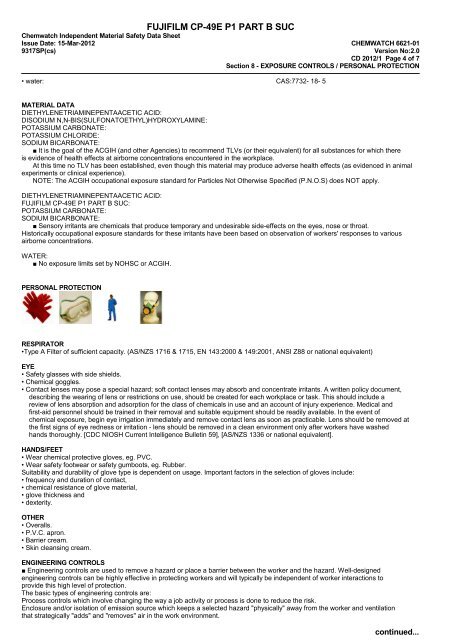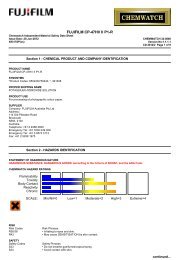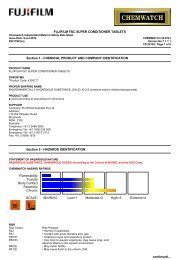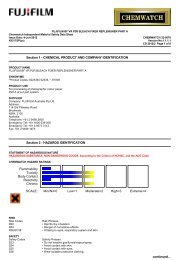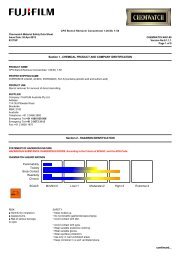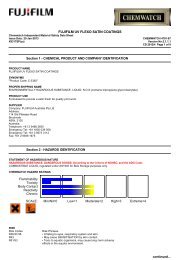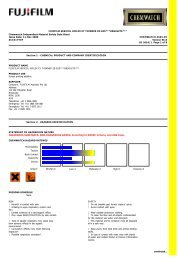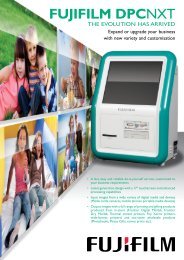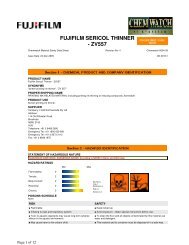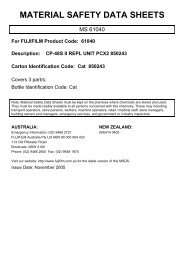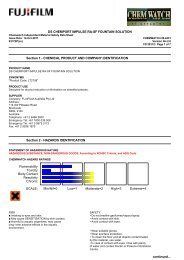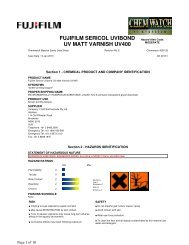Chemwatch Australian MSDS 3826981 - FUJIFILM Australia
Chemwatch Australian MSDS 3826981 - FUJIFILM Australia
Chemwatch Australian MSDS 3826981 - FUJIFILM Australia
You also want an ePaper? Increase the reach of your titles
YUMPU automatically turns print PDFs into web optimized ePapers that Google loves.
<strong>FUJIFILM</strong> CP-49E P1 PART B SUC<strong>Chemwatch</strong> Independent Material Safety Data SheetIssue Date: 15-Mar-2012 CHEMWATCH 6621-019317SP(cs)Version No:2.0CD 2012/1 Page 4 of 7Section 8 - EXPOSURE CONTROLS / PERSONAL PROTECTION• water: CAS:7732- 18- 5MATERIAL DATADIETHYLENETRIAMINEPENTAACETIC ACID:DISODIUM N,N-BIS(SULFONATOETHYL)HYDROXYLAMINE:POTASSIUM CARBONATE:POTASSIUM CHLORIDE:SODIUM BICARBONATE:■ It is the goal of the ACGIH (and other Agencies) to recommend TLVs (or their equivalent) for all substances for which thereis evidence of health effects at airborne concentrations encountered in the workplace.At this time no TLV has been established, even though this material may produce adverse health effects (as evidenced in animalexperiments or clinical experience).NOTE: The ACGIH occupational exposure standard for Particles Not Otherwise Specified (P.N.O.S) does NOT apply.DIETHYLENETRIAMINEPENTAACETIC ACID:<strong>FUJIFILM</strong> CP-49E P1 PART B SUC:POTASSIUM CARBONATE:SODIUM BICARBONATE:■ Sensory irritants are chemicals that produce temporary and undesirable side-effects on the eyes, nose or throat.Historically occupational exposure standards for these irritants have been based on observation of workers' responses to variousairborne concentrations.WATER:■ No exposure limits set by NOHSC or ACGIH.PERSONAL PROTECTIONRESPIRATOR•Type A Filter of sufficient capacity. (AS/NZS 1716 & 1715, EN 143:2000 & 149:2001, ANSI Z88 or national equivalent)EYE• Safety glasses with side shields.• Chemical goggles.• Contact lenses may pose a special hazard; soft contact lenses may absorb and concentrate irritants. A written policy document,describing the wearing of lens or restrictions on use, should be created for each workplace or task. This should include areview of lens absorption and adsorption for the class of chemicals in use and an account of injury experience. Medical andfirst-aid personnel should be trained in their removal and suitable equipment should be readily available. In the event ofchemical exposure, begin eye irrigation immediately and remove contact lens as soon as practicable. Lens should be removed atthe first signs of eye redness or irritation - lens should be removed in a clean environment only after workers have washedhands thoroughly. [CDC NIOSH Current Intelligence Bulletin 59], [AS/NZS 1336 or national equivalent].HANDS/FEET• Wear chemical protective gloves, eg. PVC.• Wear safety footwear or safety gumboots, eg. Rubber.Suitability and durability of glove type is dependent on usage. Important factors in the selection of gloves include:• frequency and duration of contact,• chemical resistance of glove material,• glove thickness and• dexterity.OTHER• Overalls.• P.V.C. apron.• Barrier cream.• Skin cleansing cream.ENGINEERING CONTROLS■ Engineering controls are used to remove a hazard or place a barrier between the worker and the hazard. Well-designedengineering controls can be highly effective in protecting workers and will typically be independent of worker interactions toprovide this high level of protection.The basic types of engineering controls are:Process controls which involve changing the way a job activity or process is done to reduce the risk.Enclosure and/or isolation of emission source which keeps a selected hazard "physically" away from the worker and ventilationthat strategically "adds" and "removes" air in the work environment.continued...


